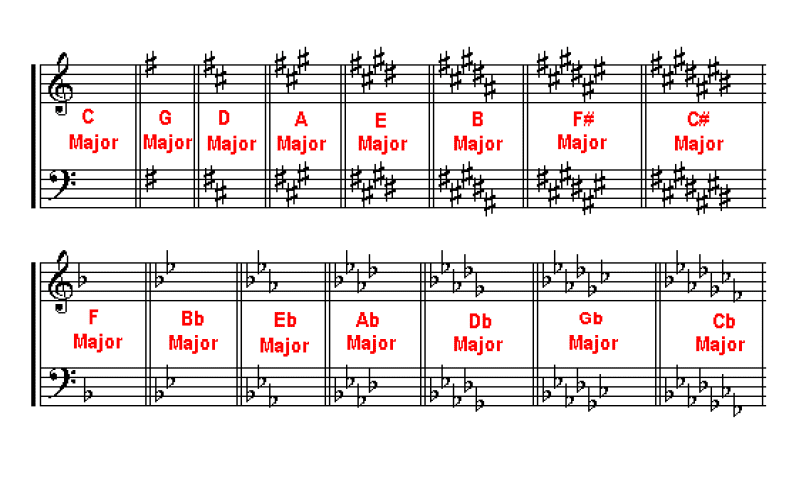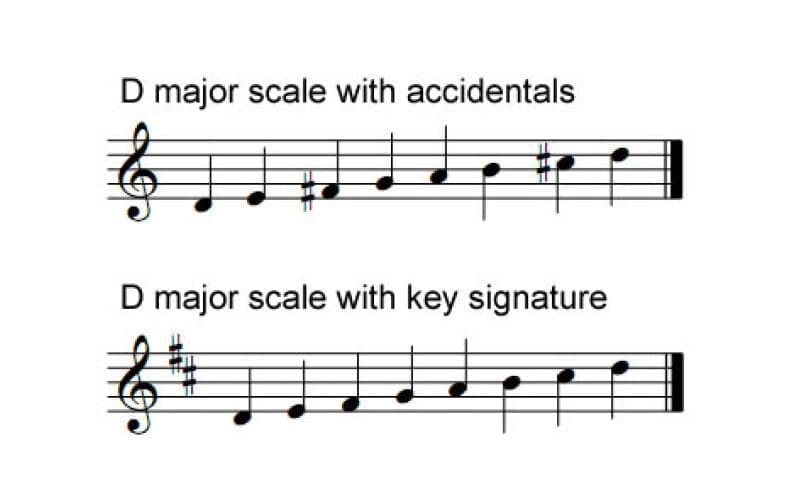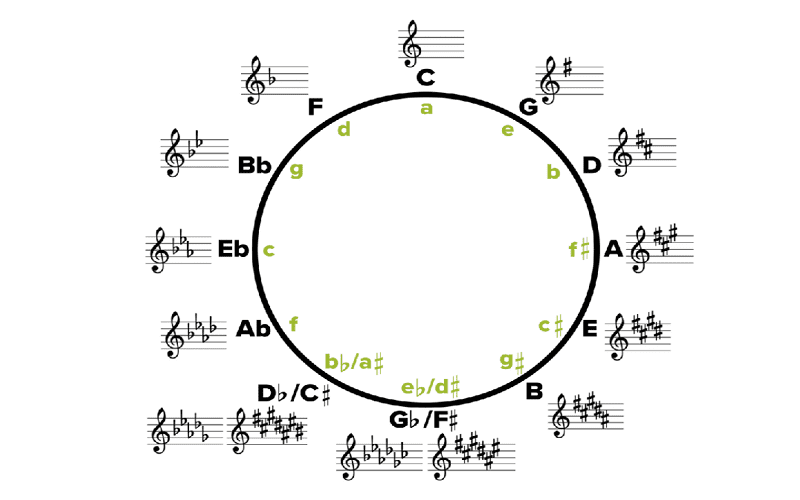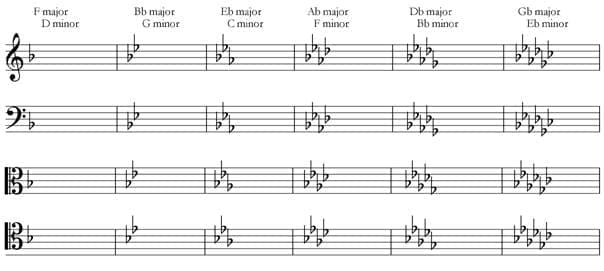Music theory is the study of the language and notation of music and key signatures are a vital part of this. It is the analysis and understanding of how music is created and structured.
Music theory explores the fundamental elements of music such as melody, harmony, rhythm, and form. It also examines the relationships between these elements, as well as the ways in which they interact to create music.
Music theory is essential for understanding and appreciating music, and for creating and performing it. It is also beneficial for developing an understanding of music history and for developing music literacy.
In this article, we explore all things related to key signatures and how they work, so let’s begin.

What Are Key Signatures & How They Work
In music, a key signature is a symbol that usually appears on sheet music to tell you what key a piece of a song is in. Most major and minor keys include accidental notes such as a sharp (♯), a flat (♭) or sometimes a natural (♮), however, in signature keys these notes are rearranged to the beginning of the staff to make it easier to read.
This form of music notation was not common until the late Baroque and early Classical periods.
However, some music that was composed between the 1720s -1740s used key signatures showing accidentals on both octaves for notes which fall within the staff.
Example of A Signature Key
Either made up of a group of flats or a group of sharps, they appear written on the staff and will fall in between the clef symbol and the time signature.
There are 15 differences to identify 12 different notes. The signature is a sign to the musician that they need to change the way the note is played so it fits with the key.
The key of C Major uses the notes C, D, E, F, G, A, and B. The key of C Major uses no sharps or flats. It is the only major key using no sharps or flats so therefore the signature key remains blank.
To illustrate key signatures a bit better we are going to use D Major. The major scale of D major uses the notes D, E, F#, G, A, B, and C#. The key of D Major has two sharps — F# and C#. This scale is the only major key with two sharps.
From above, you can see the signature is just a grouping of the accidentals that would have appeared in the scale. It makes music much simpler to read and allows the musician to identify the “key” of the music more easily.
All the keys follow this pattern although it may take a little while to remember all 15 keys. Knowing and learning scales is an invaluable tool for songwriters and composers.

How Do Key Signatures Work in Written Notation?

In music notation, the key signature tells the musician which notes to play sharp or flat. If you are playing a song in a certain key, the same notes will be sharp or flat during the entire song. The same notes appear numerous times throughout songs – having to write flats major or sharps every time a certain note appears can be a tedious process.
Instead, a key is placed at the beginning of the music in the key signature. The reader is expected to remember to sharpen or flatten those notes as they play.
Below is a table that is referenced from the music notes website (thank you) which illustrates the relationship between the 12 different notes and their relative signatures.
The Order Of Sharps & Order Of Flats
There is a certain order in which a note or pitch that is not a part of the scale is written in a key signature. If you have studied the circle of fifths then this will not be news to you. If you are unaware of the pattern, there are two easy rhymes to help you remember:
- Signature keys with sharps: Father Charles Goes Down And Ends Battle
- Signature keys with flats: Battle Ends And Down Goes Charles Father
Below are the keys in order of how many sharps/flats there are in each key:
Sharps
- Key of G = 1 sharp
- Key of D = 2 sharps
- Key of A = 3 sharps
- Key of E = 4 Sharps
- Key of B = 5 Sharps
- Key of F# = 6 Sharps
- Key of C# = 7 Sharps
Flats
- Key of F = 1 Flat
- Key of B = 2 Flats
- Key of E = 3 Flats
- Key of A = 4 Flats
- Key of D = 5 Flats
- Key of G = 6 Flats
- Key of C = 7 Flats
Key Signatures Chart
Let’s continue on our journey of signatures explained in detail and visualised by this chart below.

The Key Signatures Circle Of Fifths
The circle of fifths is a musical concept that is used to describe the relationships between the 12 tones of the chromatic scale (commonly called the circle). It is a circular arrangement of the 12 notes, in which each note is a perfect fifth away from its predecessor.
The circle of fifths is an important tool for understanding the relationships between chords and keys in music. It is also used to help musicians understand the structure of different musical styles. In addition, it can be used to transpose music from one key to another.
When applying the circle of fifths is a useful tool for both beginners and experienced musicians alike.
FAQs –Signatures
What is an A Minor key signature?
An A Minor key signature is a musical notation that indicates that the piece of music is in the key of A Minor. This key signature consists of three sharps: F#, C# and G#.
What is an E Minor key signature?
The notes of the E Minor scale are E F# G A B C D. It has 1 sharp.
What is a B Major Key Signature?
A B Major key signature is a series of sharps or flats that indicate which notes should be played in a piece of music written in the key of B Major. In B Major, the key signature consists of five sharps: B C# D# E F# G# A#.
What is a B Minor Key Signature?
B minor is a minor scale based on B, consisting of the pitches B, C♯, D, E, F♯, G, and A. Its key signature has two sharps. Its relative major is D major and its parallel major is B major. B minor.
What is an E Major Key Signature?
An E Major key signature is a set of sharps or flats that indicate which notes should be played in a piece of music written in the key of E Major – E F# G# A B C# D#. It consists of four sharps: F♯, C♯, G♯, and D♯.
What is an F major Key Signature?
An F major key signature is a set of sharps or flats that represent the notes in the F major scale. The notes of the F Major scale are F G A Bb C D E. It has 1 flat.
What is an F Minor Key Signature?
The notes of the F Minor scale are F G Ab Bb C Db Eb. It has 4 flats.
What is a G Minor key signature?
The notes of the G Minor scale are G A Bb C D Eb F. It has 2 flats.
Clefs
What is a key signatures bass clef?
A key signature bass clef is a musical notation that indicates which notes should be sharped or flatted within a particular key. It is written at the beginning of a piece of music and can help guide the performer in understanding the correct notes to play.
What is a treble clef?
A treble clef is a musical symbol placed on the left side of a 5-line stave before key and time signatures. This symbol indicates the specific order of pitches. The treble clef is the most commonly used clef in modern music and is used for most voices and instruments in the soprano and alto ranges.
What is a tenor clef?
A tenor clef is a type of musical notation that is used to indicate that the notes should be read in the tenor range. It is written as a C clef with the middle line representing the note G. This clef is most commonly used for the cello, trombone, and some choral music.
What is an Alto clef?
The Alto clef is a C clef on the 3rd line of the staff T- which is middle C. This clef allows instruments to play notes above and below middle C with ease. Alto clef is commonly used in vocal music and is also used in some instrumental music, such as viola and alto trombone.
Things to Remember When Writing and Composing Music
You should always keep in mind that for every major key signature, there is a relative minor.
It is vital that musicians memorise all the key signatures, including both variations of the Enharmonic keys. Enharmonic Keys are key signatures that have the same pitches but are named differently.
These keys are B Major/Cb Major, F# Major/Gb Major, and C# Major/Db Major.
These three sharp/flat keys are practically the same on the piano or keyboard and share the same place on the Circle of Fifths, but they can be identified with two different names and function differently in music theory. You should also remember there is a natural key.
As mentioned above, the key of C major has no accidental keys and therefore is a neutral signature key.
Conclusion and advice
This key signature system may seem like a lot to remember, but in theory, it is quite simple to grasp.
As you begin to memorise keys as every musician should, you will see it is more practical for the notes to be written this way as it makes music a lot easier to read.
Knowing key signatures when it comes to playing your instrument will enhance your ability to play and write more freely and be more creative with music composition.
Getting to grips with the way the music is written will also allow you to develop a better understanding and knowledge of the fundamentals of music.










